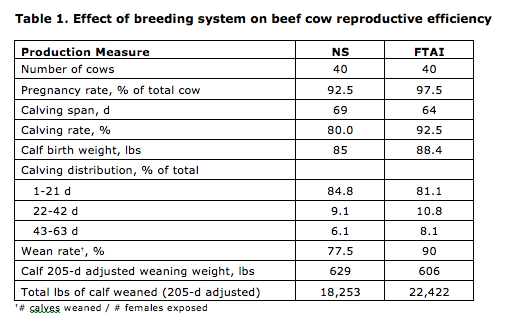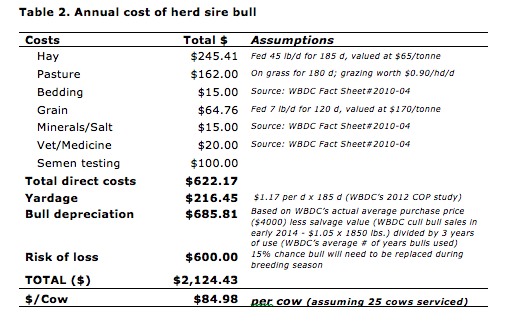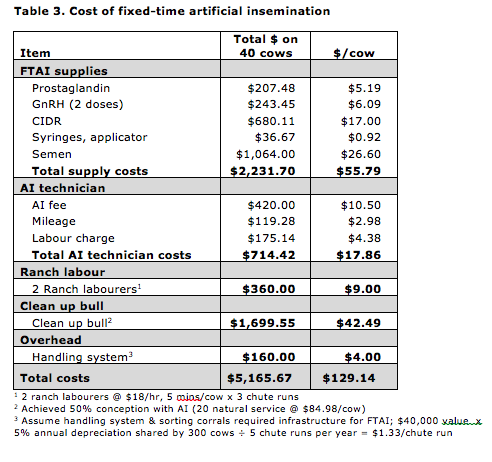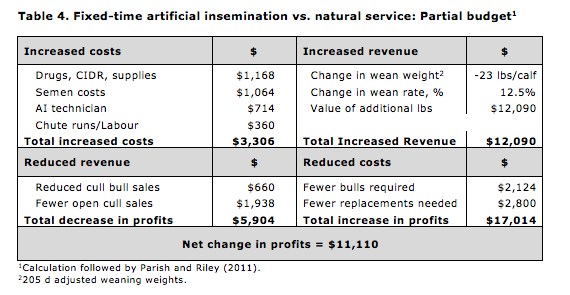Comparison of Fixed-Time Artificial Insemination vs. Natural Service in Beef Cows: Reproductive Efficiency and System Cost
Project Title
Beef Cattle Breeding Programs: A Systems Comparison
Researchers
Dr. Bart Lardner blardner.wbdc@pami.ca
Bart Lardner, PhD (Western Beef Development Centre) Daal Damiran, PhD (University of Saskatchewan) Kathy Larson, MSc (Western Beef Development Centre)
| Status | Project Code |
|---|---|
| Completed March, 2015 | 20120423 |
BACKGROUND
Fixed-time artificial insemination (FTAI) programs can be advantageous to cow-calf producers because they reduce the time and labor required for the detection of estrus and allow for the introduction of sires with superior genetics. One of the primary deterrents for FTAI adoption is the perceived cost (Parish and Riley, 2011). The common breeding system for commercial cow-calf producers in western Canada is natural service (NS; bull breeding). With limited information available on FTAI compared to natural service breeding in western Canada, the objective of this one-year study was to compare the two different breeding systems providing results on conception, calf performance and cost.
OBJECTIVES
- The objectives of this project were to evaluate two different breeding management systems – fixed-time artificial insemination and natural service – in terms of their effect on reproductive efficiency and costs.
WHAT THEY DID
The study was conducted at the Western Beef Development Centre’s Termuende Research Ranch near Lanigan, Saskatchewan. In late June, 80 black Angus beef cows (5-6 yr of age) were stratified by parity, prior calving date and body condition, then randomly assigned to either (i) a 7 day (d) CO-Synch+CIDR (controlled internal drug release) estrus synchronization followed by artificial insemination (FTAI) or, (ii) a NS 63 d breeding program (40 cows for each treatment).
The 7-d CO-Synch + CIDR protocol for the FTAI cows involved inserting a CIDR (intravaginal progesterone releasing device) and giving a 2 mL injection of Cystorelin (GnRH) on d 0. On d 7, the CIDR was removed and cows were given 2 mL of Estrumate (prostaglandin). Approximately 56 h later (d 10) the cows in the FTAI treatment received another 2 mL injection of Cystorelin (GnRH) and were artificially inseminated by a trained AI technician on July 20th.
The cows assigned to the NS program were exposed to bulls that passed a breeding soundness evaluation at a cow: bull ratio of 25:1 for a 63 d breeding season.
Breeding Season and Pregnancy Diagnosis
Ten days after FTAI, intact cleanup bulls that were tested by a trained veterinarian for disease and fertility were placed with the cows for a 47 d period. Pregnancy diagnosis was performed 90 d after FTAI on 18 October 2013 by a veterinarian using rectal palpation to determine conception rate. Following pregnancy diagnosis all cows were group managed and moved to extensive winter feeding programs. Calving began in April 2014.
Reproductive Performance
Reproductive data collected during calving included calf birth date and calf birth weight within 24 h after calving. Calving span and calving distribution were calculated for both treatments. Calves were weaned on 2 October 2014. Calf weaning weights are reported as 205 d adjusted weaning weights.
Economic Analysis
A partial-budget analysis was used to compare the FTAI with NS program. A partial budget is a quick analysis tool that does not address all the costs on the ranch, only the costs and revenues that will change if the management practice under consideration is implemented. In partial budget analysis, advantages from the change (increased revenues and decreased costs) are compared against disadvantages (decreases in revenues and increases costs). The disadvantages are subtracted from the advantages to give the net position on the management practice being considered.
WHAT THEY LEARNED
Reproductive Performance
Cow reproductive data are presented in Table 1. The FTAI program had greater cow pregnancy rate (97.5 vs. 92.5%), calving rate (92.5 vs. 80.0%) and calf birth weight (88.4 vs. 85.6 lb); but had a lower proportion of cows calving in the first 21 d (81 vs. 85%), a shorter calving span (64 vs. 69 d), and lighter 205-d adjusted weaning weights (606 vs. 629 lb) than the NS program.


Economics of Breeding Systems
Table 2 shows the breakdown of the costs associated with keeping breeding bulls on the ranch. Table 2 also summarizes the assumptions that have been made for these estimations. Both assumptions (Larson, 2010) as well as actual WBDC numbers have been used for winter feed and grazing costs, yardage, veterinary/medical costs, purchase and cull prices, years of use and cow:bull ratio. The average annual cost for a bull is estimated to be $2,124. Divide this by 25, which is the number of females the bull is expected to service, and the per cow cost of a bull works out to just under $85 per cow (Table 2).
Table 3 shows the breakdown of the costs associated with FTAI. The breeding costs for 40 cows was $5,165 or $129 per cow.
Partial-budget analysis compared the FTAI with NS program, results are presented in Table 4. Increased costs are those associated with the 7d CO-Synch + CIDR protocol, semen, AI technician, chute runs and labour. The decreased revenues result from requiring fewer bulls if AI implemented (assumed 50% fewer bulls required) and increased conception will result in fewer open cull sales. Increased revenues are generated through improvements in conception and wean rate and wean weight. In this study, 205-d adjusted wean weights for the FTAI calves were lower than for NS born calves, but improved wean rate resulted in greater total pounds weaned (22,422 vs. 18,253 lbs). The additional pounds weaned was valued at $2.90/lb based on Fall 2014 weaned calf prices. Reduced costs result from requiring fewer herd sires (due to estimated 50% being bred AI) and 5% fewer replacements valued at $1,400/hd. Overall, the net change in profit due to FTAI program was $11,110 over the NS program.


WHAT IT MEANS
The natural service program can be a lower cost (approximately $44 less) option than a FTAI program on a per-cow basis. However, this study observed improvements in conception rate, calving span, calving rate, calf weaning rate resulting in an $11,110 net increase in profit by replacing natural service breeding with FTAI – which, based on this example, may make FTAI worth considering. Thus FTAI can be a valuable tool for beef producers. Nevertheless, producers should critically evaluate their own operation’s goals to determine which type of breeding system to use, taking into account their own production costs, need for improved genetics, and management capabilities.